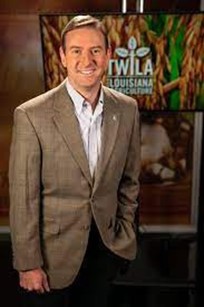 Avery Davidson, communications director for Louisiana Farm Bureau Federation and farm broadcaster on the Voice of Louisiana Agriculture Radio Network, covered the damage of Hurricane Ida, something many farm broadcasters do not get the chance to cover.
Avery Davidson, communications director for Louisiana Farm Bureau Federation and farm broadcaster on the Voice of Louisiana Agriculture Radio Network, covered the damage of Hurricane Ida, something many farm broadcasters do not get the chance to cover.
This detrimental hurricane tore through Louisiana at the end of August 2021.
“Hurricane Ida really packed a punch,” Davidson said. “It was every bit of a category-four storm.”
Several hurricanes have hit Louisiana since the 1990s, and Davidson said this storm was comparable to a hurricane that is infamous for wind damage.
“Like Hurricane Laura, the type of damage Ida brought was a very strong windstorm,” Davidson said. “It was not as strong with the deluge of rain as we’ve seen with other storms.”
The strong winds resulted in damage to multiple sectors of Louisiana agriculture, including the sugarcane industry.
“We knew with where it was going, in southeast Louisiana, it was going to impact the Louisiana sugar industry at one of the worst possible times – right before harvest,” Davidson said.
At the time of the hurricane, the sugarcane was already tall, lush, and a month away from harvest. The storm affected about a quarter of the entire sugarcane crop for the state.
“It had the potential to be really, really bad,” Davidson added. “Fortunately, sugarcane is resilient, so the storm only damaged about 25% of the crop.”
While the hurricane was detrimental to the crops in the state, Davidson mentioned it was not the only focus of his coverage. Hurricane Ida destroyed docks and almost wiped out several fisheries.
According to Davidson, there were very few buildings escaped the wrath of the hurricane.
“We knew going in that this was going to be more than a story about crops, it was going to be a story about people . . . people who were losing their homes and people who were possibly losing their livelihoods,” Davidson added. “
Alongside the sugarcane operations and fisheries, the forestry industry also was affected by the storm.
“There are still trees down all along the wooded areas,” Davidson noted. “It looks like someone came and toppled them over with their hands as if they were giants.”
Many people don’t think of the trees as an agricultural product, but Davidson emphasized they are still a large sector of the industry.
“That’s the forestry industry we have here,” Davidson said. “Someone’s investment made 20 to 40 years ago was destroyed before it could even be harvested.”
Livestock ended up being scattered throughout the state because fencing was destroyed due to falling trees and downed power lines.
“A number of ranchers had to sell off their herds, not because they were in extreme financial stress, but because they did not have the ability to repair their fences fast enough to keep those herds in place,” Davidson said.
His experience with covering similar storms gave Davidson an idea of what to expect, but this storm also took a toll emotionally.
“There were power lines all over the roads, light poles snapped, and homes and buildings damaged or destroyed,” Davidson said. “I’ve known a particular farmer for years, and his home was a total loss. Those are the kinds of things you really carry with you after.”
Davidson’s coverage of this detrimental event served as a resource for the Louisiana Farm Bureau to help make federal disaster funds available to farmers and ranchers.
“Covering the damage of this hurricane showed me a little more about how agriculture and farm journalism can shine a light on the needs of those in the farming and ranching communities,” Davidson said. “It gave me a better idea of how going out and telling someone’s story can affect change for many.”
He spread awareness of the conditions and hardships Louisiana farmers and ranchers were going through to help make a change.
“You always want to do more to help, but the best you can do as an ag journalist is make sure everyone else knows what’s going on,” Davidson concluded. “Don’t let it be forgotten.”
